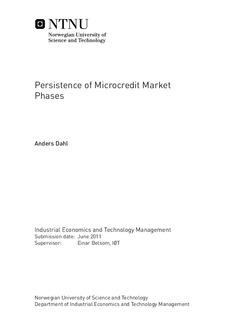Persistence of Microcredit Market Phases
Master thesis
Permanent lenke
http://hdl.handle.net/11250/265887Utgivelsesdato
2011Metadata
Vis full innførselSamlinger
Sammendrag
I formulate a phase theory of microcredit market dynamics. The theory is developed and validated using an in-depth multiple case study examining three mature microfinance markets: Bolivia, Bosnia and Herzegovina, and Morocco. I present a specific case study framework that is used to analyze each of the three markets separately. This framework combines qualitative and quantitative empirical analysis through the evaluation of 12 specific indicators. These indicators are chosen to represent four different market dynamics that are believed to affect microfinance institutions and their performance.A cross-case analysis is conducted to detect similar patterns across the three mature markets, and the findings are summarized into the phase theory. I present a theory of six different phases that a microfinance market goes through from its emergence until the crisis is resolved. Some of the important findings across the three cases are rapid growth, increased bargaining power of consumers and excessive funding to the microfinance institutions, all in the time period leading up to the repayment crisis.In essence, the phase theory predicts that a market that grows beyond what is sustainable and controllable will eventually crash when macroeconomic instability occurs. To make sure a market maintains a sustainable growth, it s important for the microfinance institutions to focus on long-term profitability over short-term growth. Mechanisms for information sharing are also essential to eliminate the new information asymmetries that arise from introducing competition in microcredit markets.I also examine a microfinance market that is under development: Cambodia. This market has not yet experienced a repayment crisis, and I apply the phase theory on this case market to assess how likely it is that it will.
